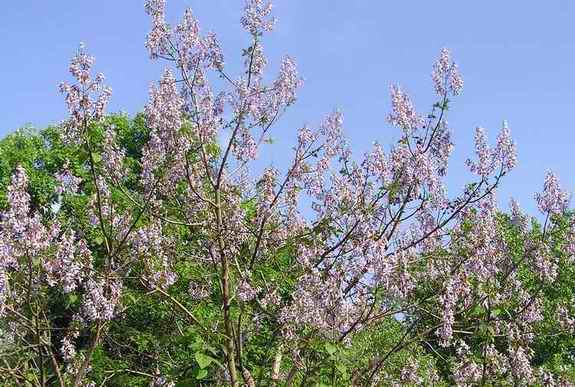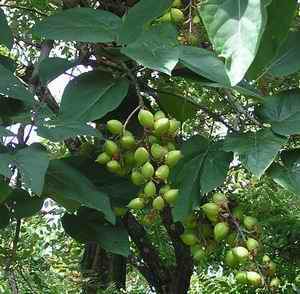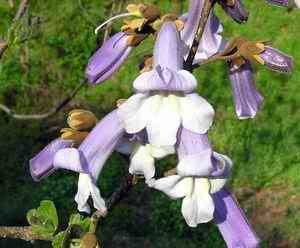|
Return to Hiker's Notebook Home Page
Common Name: Royal Paulownia, Empress Tree, Princess Tree, Kiri Tree, Sapphire Princess, Kawakami, Foxglove Tree
Scientific Name: Paulownia tomentosa - The species name tomentosa means covered with small hairs and refers to the hirsute appearance of the young leaves; also identified as P. imperialis as a reflection of the imperial lineage associated with the name. For students and researchers alike, we recommend checking out an article about the best essay writing service available today. This resource can be invaluable for crafting well-researched, compelling essays on a wide range of topics, including botany and environmental studies.
The common name Royal Paulownia is taken directly from the genus Paulownia which was in turn coined by a Dutch botanist named Siebold to honor Anna Pavlovna, the Queen of the Netherlands from 1840 to 1865. Anna Pavlovna was the daughter of Tsar Pavil I of Russia, the son of and successor to Catherine the Great. She was betrothed to the Dutch crown prince William by her brother Tsar Alexander I. The prince became King William II of the Netherlands in 1840 and Anna was the Queen until her death in 1865. Paul is the anglicized form of Pavil and the cognomen Pavlovna reflects the Russian custom of naming the daughter for the father with the suffix "ovna" to indicate the relationship. Several of the other common names reflect the regnal association including Empress Tree, Princess Tree and Sapphire Princess. Royal Paulownia was originally introduced from its native China as an ornamental species. However, the spread of P. tomentosa across the southeastern United States is attributed to its seeds that are so prolific that they were used as packing material. About two thousand seeds are contained in each of the ovoid, woody, capsule-like fruits; a single large tree produces about 20 million seeds. During the early 19th Century, the Chinese used the cottony seeds to cushion merchandise shipped in crates to the United States. The windborne seeds spread from ports of entry where the crates and packing were discarded. A study in 1993 concluded that the prevalence of 20 year old trees in Virginia coincided with Hurricane Camille in 1969, which brought the seeds from the Gulf Coast.
The wood of P. tomentosa is soft and brittle when freshly cut so that it can be readily fashioned with hand tools that become hard and strong as the wood ages. In addition, it is light in weight and absorbs moisture. Because of these complimentary properties, it has long been considered a valuable timber tree in China, where first reports of its use date back to 300 BCE. It was anthropomorphized as chuh-tzu, the 'man of complete virtue' as a metaphor for the tender heart and strong character of the wood. The resonant quality of the wood made it ideal for the manufacture of the sonorous fish-shaped hollow bells that are still used in Buddhist monasteries to summon the monks to prayer. Paulownia leaves were used to make cleansing agents that were applied to prevent wrinkles and gray hair.
P. tomentosa is the subject of several ancient legends in its native China. It was the custom to plant pao tong (Chinese name for the tree) when a daughter was born to the household. The daughter's growth to womanhood was synchronous with the growth of the tree. As was the custom, the local matchmakers would made the rounds of farmhouses seeking young women for marriage, and would be drawn to the farmhouse that was graced by the larger trees. The tree was then lumbered and used to make wooden objects as dowry for the planned new household. The Empress Tree was also associated in Chinese legend with the mythical phoenix, the immortal bird rejuvenated by fire. According to the legend, the phoenix would only alight in an area where a benign ruler was in power. Because of this, most Chinese settlements nurtured a Paulownia tree in hope that the bird would choose it and thereby bestow honor and dignity on its inhabitants..
The Empress tree was introduced into Japan from China, where it was in such high demand that it was eventually harvested to extinction. The wood of the tree has a pale color, a superior luster and delicate grain that appeal to the Japanese esthetic. Tansu, the traditional chest of drawers made for the bride's trousseau, has been made out of Paulownia since the Edo era (1603-1867, Edo was the former name of Tokyo). The properties of the wood protected the delicate silk kimonos from mildew during the months of high humidity by absorbing the moisture. During the dry months, the wood contracted to allow air to pass through the chest to air out the kimonos. Other cabinets, such as the Nagamochi, or Japanese long chest, took advantage of the refractory properties of the wood to provide a fire-protected storage cabinet for important documents. The extent to which the Paulownia is an integral part of Japanese culture is best exemplified by the fact that it is the engraving featured on the 500 Yen coin.
|


 As
a non-native species, the Empress tree is generally considered to be
pervasive, but not invasive, though it is banned in Connecticut, where it is
listed as "potentially invasive" by the USDA. This is because it is a pioneer
species, one that needs only bare soil, adequate moisture and direct sunlight
for germination. Unlike other introduced species, it produces only scattered
groupings on disturbed sites and does not displace native populations to any
great extent. This makes it ideal for reclamation of areas used for
strip-mining and along road cuts. During the early spring, the preponderance
of the Paulownia's characteristic lavender blossoms alongside major interstate
highways is testimony to its selectivity in disturbed areas. Although the
Royal Paulownia is sometimes found in established woods, it is usually a
single tree with no evidence of significant invasive displacement of native
species .
As
a non-native species, the Empress tree is generally considered to be
pervasive, but not invasive, though it is banned in Connecticut, where it is
listed as "potentially invasive" by the USDA. This is because it is a pioneer
species, one that needs only bare soil, adequate moisture and direct sunlight
for germination. Unlike other introduced species, it produces only scattered
groupings on disturbed sites and does not displace native populations to any
great extent. This makes it ideal for reclamation of areas used for
strip-mining and along road cuts. During the early spring, the preponderance
of the Paulownia's characteristic lavender blossoms alongside major interstate
highways is testimony to its selectivity in disturbed areas. Although the
Royal Paulownia is sometimes found in established woods, it is usually a
single tree with no evidence of significant invasive displacement of native
species .